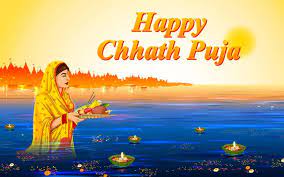Indian Festivals – Skanda Shashthi & Chhath Puja
By C.I. Sivasubramanian
Aged 95, Retired Director, Ministry of Commerce, New Delhi
Yet another great festival in praise of Lord Muruga, or Skanda, or Kartikeya as he is known in the north, is called Skanda Shashthi. It comes on the sixth day in the bright half of the Tamil month of Eippasi, or Asadha Sukla Shashthi (Oct 15 – Nov 15). It is celebrated with great pomp and splendour in the temples dedicated to Lord Muruga.
Skanda Shashthi is observed especially by the Tamils all over the world and commemorates the destruction of evil by the Supreme General Karthikeya, son of Lord Siva. This festival is celebrated in a grand manner at the ‘Aru padai veedugal’-[the six houses of the Lord where temples have been consecrated in His honour viz. Thirupparankundram, Thiruchendur, Thiruvavinankudi (more famously known as Palani), Kundruthoradal (commonly known as Thiruttani), Thiruverakam (better known as Swami Malai in Kumbakonam) and Pazhamudircholai, near Madurai], where the ‘Soora samhaaram’ (the defeat of Soorapadman, the demon) is enacted. It is an important festival wherever temples have been built for Lord Muruga, including the one in Delhi. These temples are usually built over a hill. (The names of Murugan sthal are tongue-twisting!)
In countries like Malaysia, Singapore, where many Tamils reside for centuries, this is an extremely popular and widely observed festival.
The story goes like this. When the ‘devas’ (celestial beings) couldn’t tolerate the evil doings of the demon Soorapadman, they approached the younger son of Lord Shiva and Parvati. The kind Lord went on a war against Soorapadman. The war was waged for six days, at the end of which the Lord vanquished the asura. He threw his weapon at him and Soorapadman was split into two halves. At his own request, one half became a peacock, which He took as His ‘vaahana’ (vehicle). The other became a cock and was transformed into his flag.
Lord Skanda married Devasena immediately after the defeat of Soorapadman. It is the custom to dramatize this marriage during the Skanda Shashthi celebrations.
Devotees usually narrate the Skanda Shashthi ‘Kavacham’ (a hymn in praise of the Lord), during this period. Devotees who want to get over great calamities in their life taka a vow to carry the ‘Kavadi’ (kavadian), a sort of palanquin with two baskets at either end. The baskets contain sacred water and milk. They observe strict celibacy, beg their food and offerings for the Lord and walk barefoot all the way to the famous shrine. After reaching the sanctum sanctorum they ceremonially offer the sacred water and milk to the Lord. It is quite common even for the laymen to take Kavadi.

KAVADI
It is worthwhile to note that almost all festivals celebrate victory of the Lord over the demon, who represents evil, in other words victory of good over evil. This is the common refrain of Hindu mythology.
CHHATH PUJA
It is a coincidence that another important regional festival, Chhath Puja, is celebrated on this day, mostly by people of Bihar in the north. For one night and day, the people of Bihar practically live on the banks of the river Ganga where a ritual offering is made to the Sun God.
The venue for this unique festival is the riverbank and since the Ganga traverses the countryside of Bihar like a lifeline, it is but appropriate that the banks of this river should be the ideal prayer location. Chhath is considered a means to thank the Sun God for bestowing the bounties of life on earth as also for fulfilling particular wishes.
On the day before the actual worship, devotees take a cleansing dip, preferably in the Ganges, and bring back some holy water to prepare the offerings. A fast is observed for the whole day and late in the evening, the devotees, after performing worship at home, break their fast. The offerings – typically a rice porridge, puris and bananas – are shared among family and visiting friends and relatives.
By C.I. Sivasubramanian
Aged 95, Retired Director, Ministry of Commerce, New Delhi

Mr. C.I. Sivasubramanian hails from Coimbatore. He has been living in Delhi throughout life. He was employed with the Government of India, Ministry of Commerce and retired as Director in 1986.
My Articles Contributed Here
- My Childhood Days at Coimbatore
- Idiosyncrasies Of The English Language
- My struggles to get a degree
- My First Sea Voyage
- Sakura Hanami
- Lakshadweep
- Indian Festivals – Skanda Shashthi & Chhath Puja
- Washington DC
- A Peep into China – Episode 1
- A Peep into China – Episode 2
- A Peep into China – Episode 3
- A Peep into China – Episode 4
- An Introduction – Japan Episode 1
- A Brief History – Japan Episode 2
- Tokyo, an overview – Japan Episode 3
- Japanese Life – Japan Episode 4
- Japanese Life – Japan Episode 5
- Japanese Life – Japan Episode 6
- Japanese Life – Japan Episode 7
- Japanese Life – Japan Episode 8

